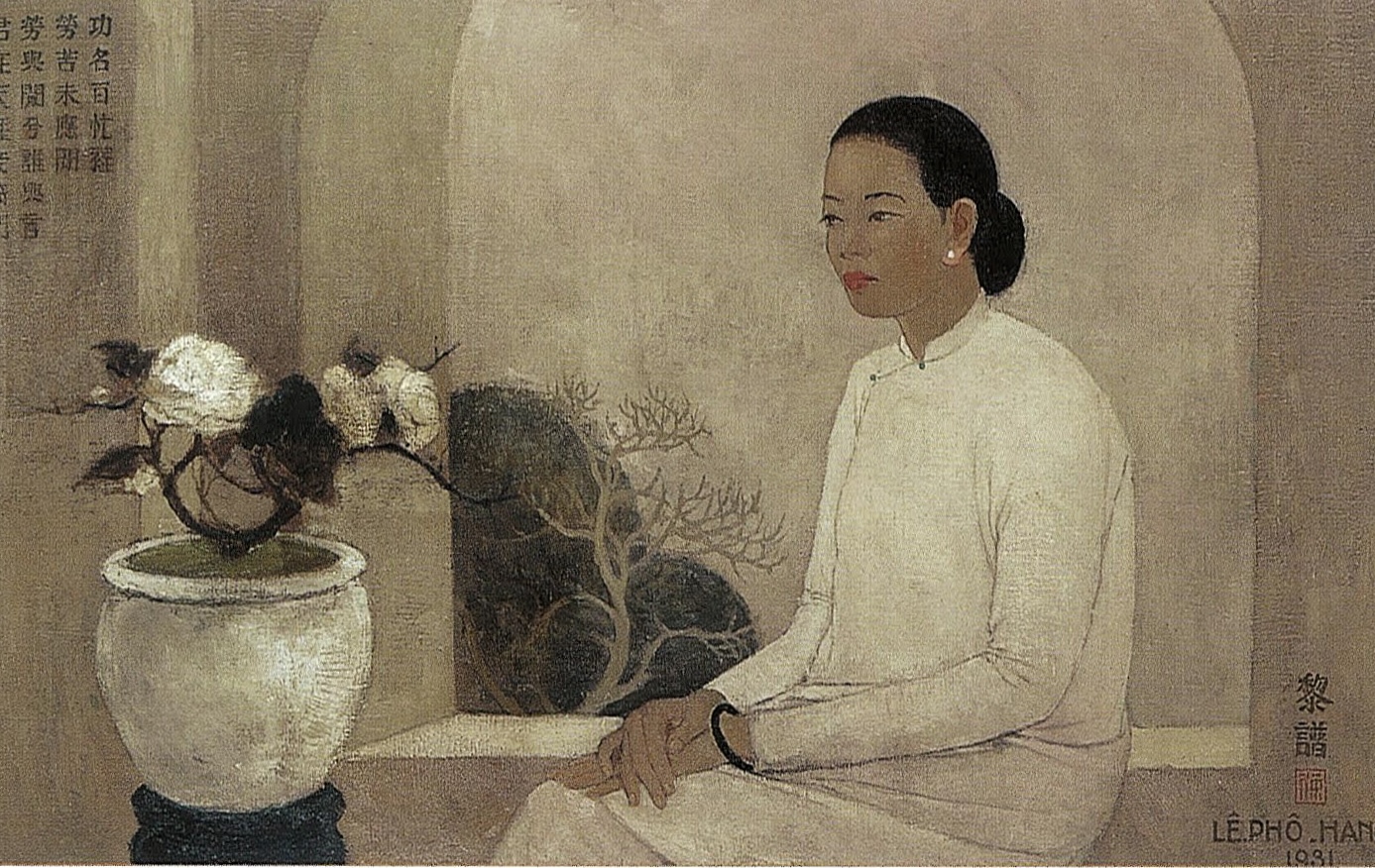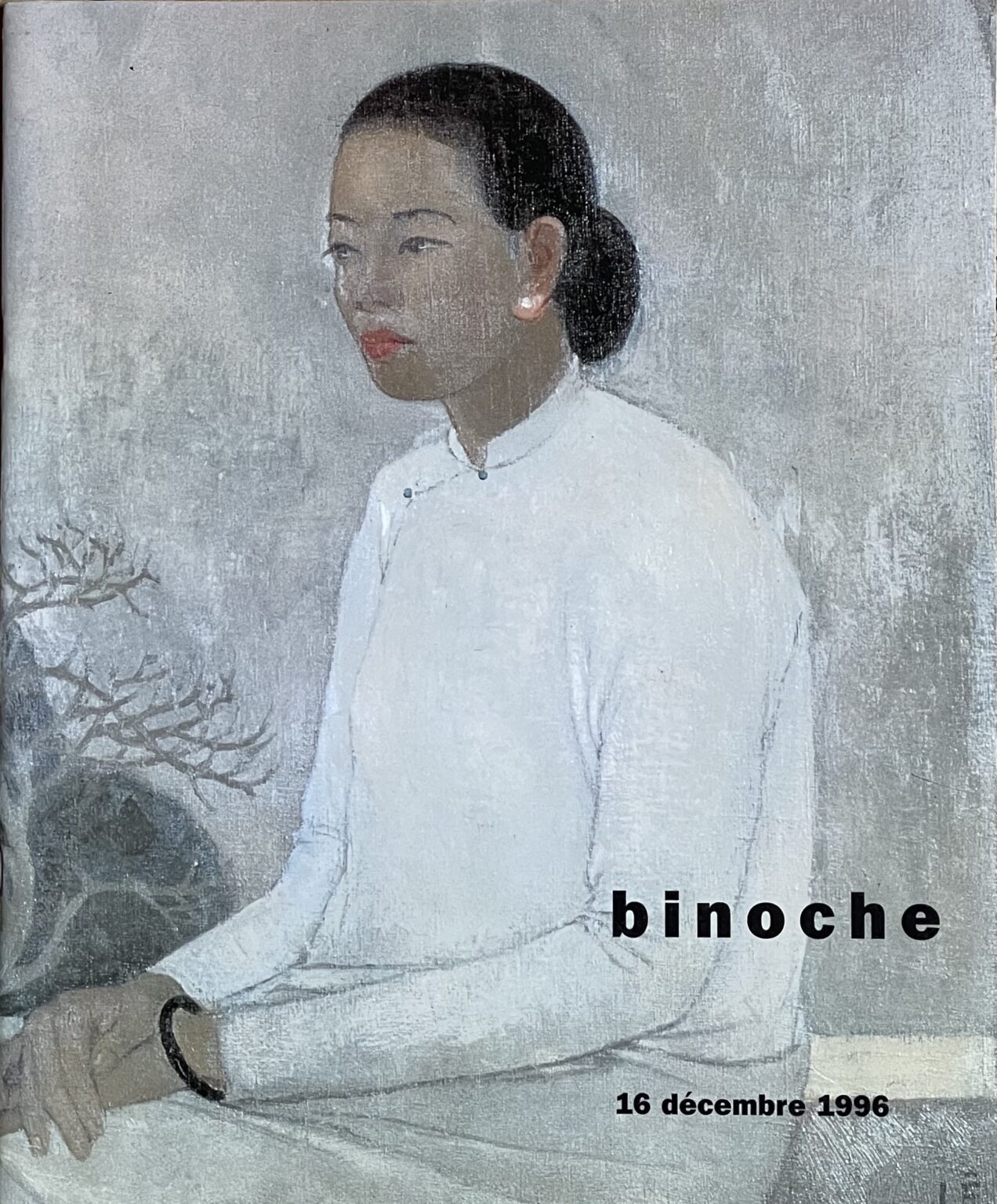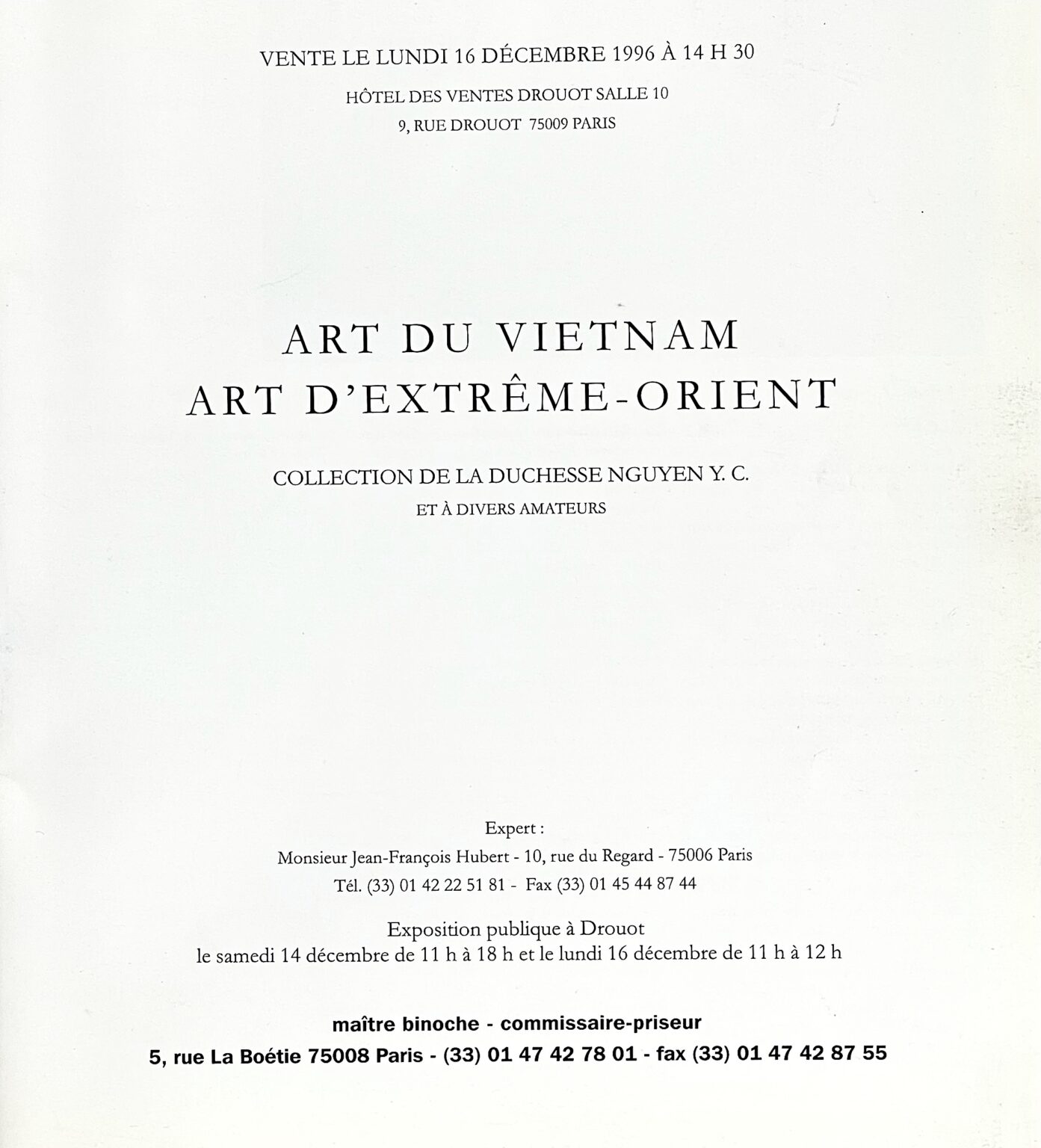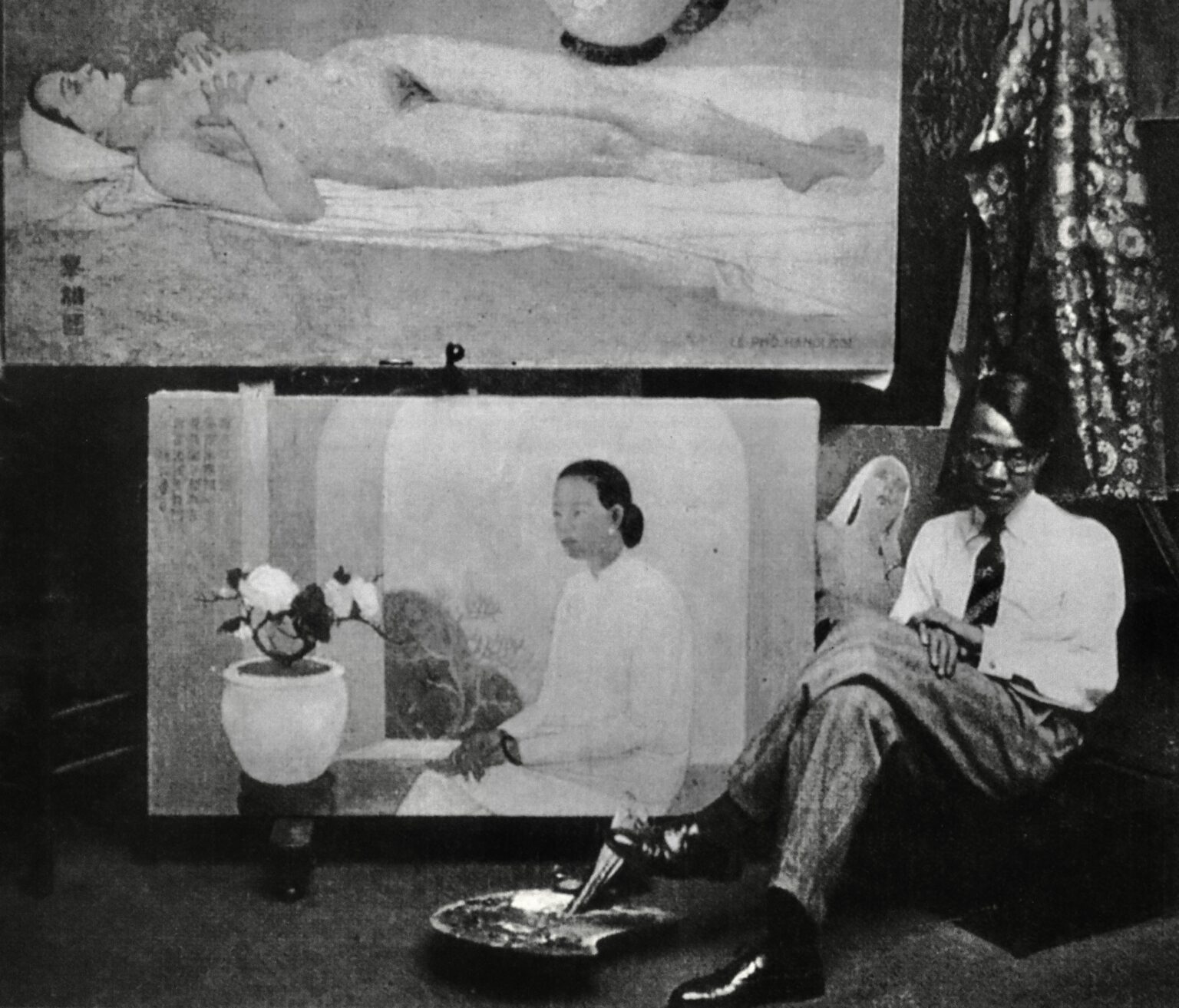
For the very first time in Vietnamese Art History, a Vietnamese masterpiece by Le Pho featured on the front page of a catalogue. On 19 December 1996, in Drouot, its estimate was EUR 8000, finally released at EUR 25,000. For now, its estimate would be EUR 2,000,000.
Le Pho (Vietnam, 1907-2001)
Femme du Mandarin (The Mandarin’s Wife)
signed and dated ‘LE-PHO 1931’ (lower right)
oil on canvas
81 x 130 cm. (31 ⁵⁷/₆₄ x 51 ³/₁₆ in.)
painted in 1931
on seal of the artist
Exhibited
Drouot, 19 December 1996 (illustrated, front cover).
Netherlands, Scheveningen, VSB Circus Theater te Scheveningen, De schilderkunst van Vietnam, 1-30 November 1997.
Le Pho, ” La Femme du Mandarin (The Mandarin’s Wife), 1931, or a vehement impassivity
Every great painter has his emblematic work. Among many others, Guernica for Picasso, Le déjeuner sur l’herbe for Manet, David for Michelangelo or La Joconde for Leonardo da Vinci. These works have this in common, they express the quintessence of the artist at his peak, and they are part of important moments in the history of Art and therefore of Humanity.
La Femme du Mandarin (The Mandarin’s Wife), by Le Pho (1907-2001) is one of those emblematic works that is both sumptuous, unique and a manifesto of Vietnamese painting.


On 16 December 1996, for the very first time in Vietnamese art history, a Vietnamese masterpiece by Le Pho featured on the front page of a catalogue. Later, at Drouot's auction on 19 December 1996, its estimate was EUR 8000 and finally the hammered price released at EUR 25,000. Nowadays, its estimate would be EUR 2,000,000.
Every great painter has his emblematic work. Among many others, Guernica for Picasso, Le déjeuner sur l’herbe for Manet, David for Michelangelo or La Joconde for Leonardo da Vinci. These works have this in common, they express the quintessence of the artist at his peak, and they are part of important moments in the history of Art and therefore of Humanity.
La Femme du Mandarin (The Mandarin’s Wife), by Le Pho (1907-2001) is one of those emblematic works that is both sumptuous, unique and a manifesto of Vietnamese painting.
When Le Pho painted this oil on canvas (81 X 130 cm) in 1931, he had graduated a year earlier from the École des Beaux Arts de l’Indochine (Indochina School of Fine Arts) in Hanoi. He was 24 years old. It was already clear that he would be one of the greatest Vietnamese painters of his century. The work is remarkable for the restrained tension expressed in this Femme du Mandarin. Her pose, hands clasped, her white Ao Dai, her bun, a discreet bracelet and a discreet earring assume the simplicity worthy of a single woman. Her plucked eyebrows, lipstick, and light facial makeup mark her independence.
The flowers of Camellia known as “white doves”, appear captured more than planted in a pot itself mechanically placed on a stand of which we only see the top are hatched but orphaned from their true mother earth. They testify to the absurdity of the world.
The rich but austere residence sees its bay opening on poor and unreal vegetation.
Together with its occupant, they bear witness to the Confucian values that regulate the Tonkinese society in which Le Pho was born. Everything is meditation and restraint. An epicureanism of abstention.
The poem at the top left in Chinese characters (it should be noted that Le Pho does not equal Nguyen Phan Chanh calligraphic skill…) is an excerpt in Chinese from Chinh Phụ Ngâm (征婦吟, Chant de la femme du combattant, Song of the Fighter’s Wife) written around 1740 by Đặng Trần Côn. Later in the late 18th century or early 19th century, Phan Huy Ích transposed it into Nôm.
The characters are as follows, with their transcription in Roman characters on the right and the text in Quốc Ngữ below and then the English translation:
功名百忙裡 Công-danh bách mang lý
勞苦未應閒 Lao-khổ vị ưng nhàn
勞與閒誰與言 Lao dữ nhàn thuỳ dữ ngôn
君在天涯妾倚門 Quân tại thiên-nhai, thiếp ỷ mônÁng công danh trăm đường rộn rã,
Những nhọc nhằn nào đã nghỉ ngơi.
Nỗi lòng biết tỏ cùng ai,
Thiếp trong cánh cửa, chàng ngoài chơn mây.Seeking glory in the midst of a thousand sorrows,
Though weary, you forget to rest.
To whom can you confide the secret of your heart?
I, behind my door and you, on the horizon!
The Chinh phụ ngâm is as famous and respected in Vietnam as the Kim-Vân-Kiều, Le Pho’s choice of text is not surprising. On the other hand, one may wonder about the selection of the verses themselves by the painter. From this long poem, he extracts a passage where “glory” and “horizon” appear, two premonitory words that identify his near future. The “Colonial Exhibition” of 1931, the successful “conquest of the West” of the painter, bringing him glory under other horizons.
The painting’s destiny also adds to its value.
A story I heard from Le Pho himself: his love for this painting was such that the painting travelled with him when he moved permanently to France in 1937. No surprise there. The themes “woman” and “absence”, so often celebrated and magnified in his work, meant that the painting could not be left behind by the traveller.
But with the declaration of the Franco-German war in 1940, Le Pho enlisted in the French army to fight against the Nazi barbarism. He had to leave behind the painting in his home as a guarantee for the payment of his rent.
When the painter returned from the war, his landlady, quite indelicately, had sold it to clear the debt… or probably exchanged it for a little food needed in these years of famine. Later, the painting reappeared in Versailles, the city of the Kings of France, in a public sale on April 18th, 1971 (number 253 “Collection M. V.”) and was bought by a French collector, a great man, Doctor Bismuth.
I saw the work for the first time in his apartment, 40 rue de Lubeck in Paris, in 1996. I was dazzled by this painting without a name and gave it the title: “La Femme du Mandarin” (the Mandarin’s Wife). Doctor Bismuth decided to let it go after 24 years of seeing it. I used it for the cover (double full page) for my sale in December 16th, 1996 at Drouot where I was an expert. No other Vietnamese painting had the honour of “The Cover”.
It attracted the interest of an unexpected number of collectors fascinated by its power and serene beauty and tripled its estimate. This was an achievement at a time when Vietnamese art only interested very few people (a few Europeans and absolutely no Vietnamese from Vietnam). This work was the impulse to phase of rapid growth Vietnamese painting, thanks to this prophetic work, to become the success we know today.
Later on, the glad new owner (and friend) will lend me later the painting for the the Royal Museum of Mariemont’s exhibition (of which I will be co-curator): La Fleur du Pêcher et l’Oiseau d’Azur, Arts et Civilisation au Vietnam, in 2002.
It was, of course, a very popular work amongst a group of very high-quality ones.
Thus, by its quality, and its historical journey, it constitutes one of the major works of Vietnamese painting of the 20th century. Beautiful and strong, it transcends us and brings us an extra soul.
There is a vehement impassivity in this “Femme du Mandarin”, a vital need to control her passion through dignity.
Like for Le Pho.
Jean-François Hubert
Senior Expert, Vietnamese Art











